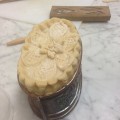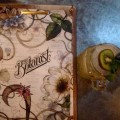I’m probably more Barbara Good than Bear Grylls so fortunately the good news is that you don’t have to be a lean mean exploring machine to ‘live off the land’ these days.
Its not a new idea. If you’ve ever been to Sat Bains you’ll know that on the menu is the ‘NG7’, a course made using food foraged from the area local to the restaurant. So we donned our dungarees and wellies and joined the Wild Food Walk led by Nottingham City Council to find out more about just what foodie items we could be passing by daily on our doorstep without even noticing.
It was every season in a day on Sunday May 11th as we debated whether to dodge the heavy rain to find a pub with a roaring log fire, or risk it and explore the great outdoors. Thankfully we chose the latter.
We met our guide for the afternoon, Park Ranger Craig, in the car park of Bulwell Hall Park which we where we begin our adventure. Alongside an 18 hole golf course, Bulwell Hall Park offers a nature reserve that, despite me growing up nearby, I never knew existed. Originally the garden of a manor house, not only is there ancient woodland, streams, a fishing lake and wildflower meadows, there is it seems a wealth of food which is readily available throughout the year.
Our guide Craig is an expert. When gathering and utilising wild food, it is vitally important to know what you are doing. There are a number of foods which can be gathered and eaten directly, others require processing in the correct way to make them safe. For example, the stinging nettle which Craig explains needs to be blanched to neutralise the sting. Once blanched they can be used for tea, soup or even beer. We learn also that anything you can eat can be made into wine! (and even some things you can’t eat too)
Different people have different tolerances to allergens and toxins so it’s advisable to try a little of the food you’ve gathered rather than a whole lot at first. If in doubt, leave it alone. In addition many wild foods have medicinal properties which you need to be mindful of if you are on medication or have any health conditions. For example, next stop is the Lime Tree, innocent looking leaves which can be used in a salad but the flowers can be dried and made into a tea which was used as a tranquilliser in WW2!
As the rain lashed down, from beneath our brollies we viewed Dandelions. A weed to most of us, yet in actual fact the whole plant can be used. Leaves and flowers in salad, whilst the roots can be dried, roasted and ground into coffee. Our walk takes us towards Hucknall, with a view over the fields of the Rolls Royce factory, we find Hawthorn another wild food which can be used in sandwiches and salad, Greater Plantain – a natural antihistamine, Lesser Celandine – a high source of vitamin C, along with Wild Rose, Elder, Birch, wild Garlic, Ground Ivy, Gorse, Pine and Broom to name but a few. Before completing our damp but interesting walk Craig treated us to a well earned Elderflower Cordial, Elderflower Wine and Oak leaf wine. We were also given a handy information booklet which included recipes.
On public land, such as parks and open spaces, permission is not generally required for gathering wild food. Be careful though, you may find that there are a number of species that can be used for wild food which are now rare and protected by law so it’s probably best to begin with a guided walk.
The Wild Food Walk is a free event which takes places regularly at parks throughout Notts. Look out for times and dates in the Nottingham City Council ‘What’s on!’ guide, visit www.nottinghamcity.gov.uk/parkevents or call 0115 9152733.
by Tanya Raybould




